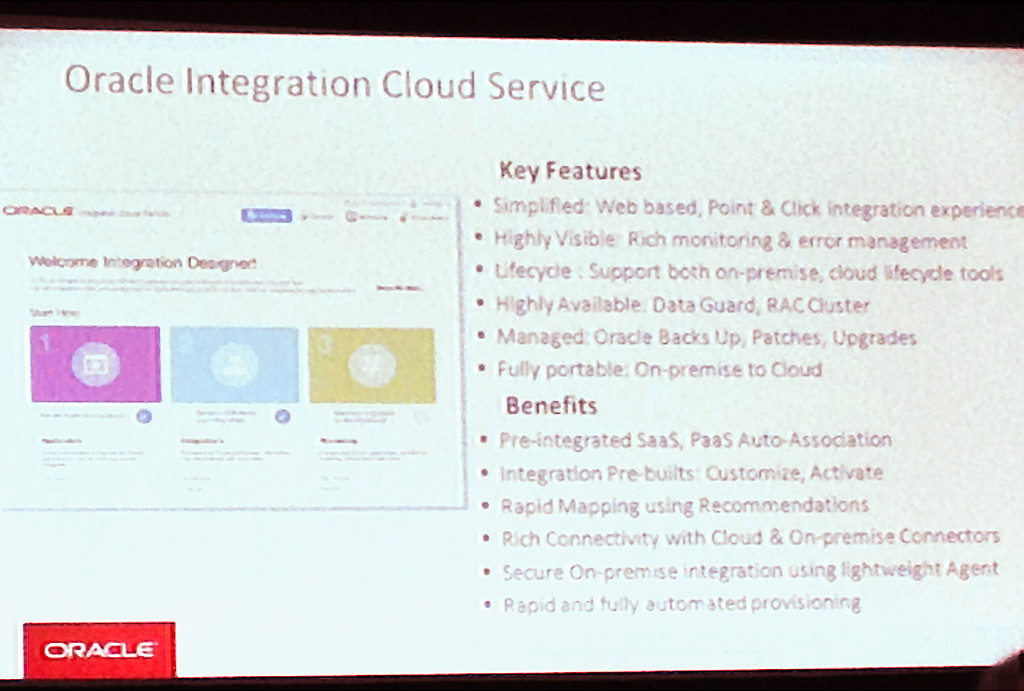Past Event: Oct 11, 2023
Customer Success with Oracle Integration Cloud - On-demand Webinar
1 min read
We were particularly looking forward to Monday’s session on Integration as a Service and it did not disappoint! Through our experiences with various CX cloud services integration projects (Sales Cloud, Marketing Cloud and Service Cloud and also cloud to on-premise with Siebel) we have naturally faced a number of challenges and have been looking forward to Oracle leveraging their considerable tech stack to help us overcome those challenges. Influential bloggers such as Oracle architect Angelo Santagata have alluded to such developments for a while so it was not with surprise, but with substantial satisfaction, that we greeted Oracle’s announcement of the iPaaS: Integration Platform as a Service.
Fig.1: Oracle Integration Cloud Service (from http://cloud.oracle.com)
Monday’s session introducing Oracle’s latest cloud services was presented by Vikas Anand (Senior Director of Business Integration and Product Management), Herbert Stiel (Vice President of Product Development and Axel Allgeier (Vice President of Software Development for SOA).
Herbert Stiel opened the session by summarising the current state of SaaS adoption (mentioning for example that in 2014 alone there were +2000 SaaS customers) and the ease of SaaS implementations. Two good points were made that summarise quite well the current state of SaaS: SaaS should not be seen as Silo-as-a-Service and also that integration needs to be as simple as SaaS.
The new iPaaS project from Oracle is designed to address these concerns, by running integration processes on proven Oracle technologies, many of which are currently running hundreds of millions of transactions a day. A common strand on OOW14 this year is the flexibility to equally run these on the Oracle public cloud or on-premise, which is neatly followed by iPaaS.
Vikas Anand presented some impressive statistics (fortunately not representative of our customer base!):
It's undeniable: Cloud introduces a new dimension of complexity, especially with on-premise integration challenges, and the key point at this time is how to simplify this complexity. Oracle is in a strategic position to enable this simplification, because of the comparative advantage afforded by years of experience and a full tech stack, capable of business process management (spanning service orchestration and business rules), analytics and event processing.
The Oracle Integration Cloud Service (iPaaS) brings solutions to the challenges of integrating SaaS to SaaS and SaaS to on-premise, by including pre-built connectors for SaaS and on-premise applications, rapid mapping, secure integration and rapid provisioning. When subscribing to the Oracle Integration Cloud Service, clients even get connectors for their corresponding SaaS subscriptions automatically provisioned for them.
 Fig. 2: Oracle Integration Cloud Service
Fig. 2: Oracle Integration Cloud Service
Axel Allgeier presented a very impressive quick demo of the new Cloud service. The first impression is clearly a very clean and uncluttered interface, where users are presented with the tasks they need to do according to their role.
The exemplified flow for a developer is as easy as 1-2-3:
The service also includes monitoring tools that allow users to monitor live requests and their statuses. Users can also search and filter the messages, based on identifiers (opportunity name, quote name, region, etc). This mix of business and integration data on integration logs has been extremely helpful in debugging difficult situations for some time.
We are really looking forward to getting our hands on iPaaS and have already highlighted many uses for it throughout our Cloud projects. Strategically, we think it makes perfect sense for our customers to start considering adding this piece to their existing architecture too.
For more information on iPaaS and to discuss how it could help your SaaS project, contact us on +44 203 283 4315 or email [email protected] now.
Keep up to date with what we learn at OpenWorld 2014 via this blog, or follow us on twitter
1 min read
Discover how Boxfusion Consulting helped IQPC realise their vision. Joining the...
2 min read
Join us at Oracle’s webcast on February 16, 2021 at 11:00 – 12:00 CET (Berlin)
1 min read